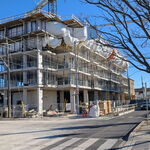micheal_can
Senior Member
Unfortunately, there is no demand for the model. Only two operators bought it: SMART and UPX. The production line is now disassembled and the cost for a unit, expensive as they were when bought during their production run, is now twice or more, if they can even be built again. Nippon Sharyo is having serious problems surviving in entirety. This follows a number of North Am attempts to restart DMU production, the previous one being http://www.usrailcar.com/documents/usrailcar-americasdmu.pdf
The only hope for RDC replacements is to get TC off their sorry arses and permit waivers like the US does. The only one that I'm aware of is OCTranspo's, and the Light Rail cars used wouldn't get a waiver for VIA Rail use on shared freight track, even though both the Talents and their replacement Coradia LINTs are used on heavy rail in Europe.
Both have been discussed previously in this string.
It is too bad Amtrak and Via do not collaborate for the production of new DMUs that meet TC standards.. We could have DMUs on old lines and they would be viable.








